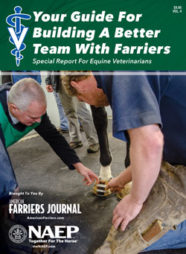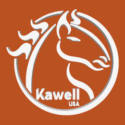Pictured Above: Indiana farrier Cody Bogard hired a marketing person to free up more of his time for horseshoeing.
Farrier Takeaways
- New farriers should use online marketing tools as well as traditional networking to find and hire potential clients.
- Social media accounts can do more harm than good when used incorrectly.
- The best marketing a new farrier can do is behave professionally and dress appropriately.
When Cicero, Ind., farrier Cody Bogard graduated from shoeing school a little over a decade ago, his mentors assured him that he didn’t need to worry about getting clients. He would have more work than he could handle in a couple of years if he did two things: show up on time and return phone calls.
“The only problem with that plan,” Bogard says, “is the phone has to ring first.”
Bogard’s first year out of horseshoeing school, he was one of six new farriers in Hamilton County — an area with a horse population of about 4,000. As a result, business was a little slower than he expected. Bogard felt fortunate to know established farriers who would let him ride along or share a client here and there. But he also knew waiting for the phone to ring was not a business plan —and he would need to do some marketing to grow his client base. Establishing a business plan early on and hiring a dedicated marketing person helped Bogard focus more on shoeing and less on social media.
Establish and Manage Your Digital Presence
Gone are the days when tack shop bulletin boards are the best way for farriers to reach potential clients. Horse owners can largely be found online —and that is where most of them are looking for farriers, Bogard says.
“When I first started shoeing in 2008-09, I built a halfway decent website, considering my limited skills, and within 2 weeks I had my first website client,” Bogard says. “At the time, I believe I was one of two farriers in Indiana who had a website, so it set me apart. Now there are many more and if you don’t have one, people wonder why.”
Bogard also invested a modest amount into paid advertising on Google and created a company Facebook page to round out his digital marketing efforts. After that, he admits he let it slip to the back burner. Over the years, however, as online engagement increased and social media use became more widespread, Bogard had to re-assess his commitment.
Everyone is marketing whether they realize it or not …
“Social media was gaining in popularity,” he says, “I knew I had to be better but I really didn’t have the time. I also knew I needed to update my website but I didn’t want to do it. I doubt any farriers really want to spend their time designing a website or writing search engine optimized web content.”
Bogard reached out to family friend Kia Apple, who has an equine background and is a skilled writer and photographer. Knowledgeable about social media and willing to invest the time to learn what she didn’t know about website design and marketing, Apple was hired as an independent contractor at first but was quickly brought on staff as the marketing director for the company.
“I figured I would hire her part-time for 5 or 6 months to get the website and social media back on track then I’d take it over. It worked out so well, she stayed on,” Bogard says, “which is fantastic because I don’t have to work on the marketing.”
Apple was initially tasked with redesigning the website and creating social media posts once a week.
“I think most people think ‘oh, it’s a quick social media post’ — and that’s true — but it’s also more,” Apple says. “It’s about engaging clients and staying up to date on what is happening in their lives.”
By staying on top of Dixie’s Farrier Service social media accounts —Facebook, Instagram, Twitter, and LinkedIn — Apple was able to learn of a client’s horse’s passing and share that information with Bogard so he could reach out to them in advance of what would have been the next scheduled shoeing.
“Clients want a relationship with their farriers,” Apple says. “It’s personal. Facebook is kind of the online equivalent of a bar. People come there to talk and share.”

Handle Negative Feedback Gracefully
Social media makes it easier than ever for people to publicly air their grievances with businesses — and farriers are no exception. No one is perfect and mistakes happen, but if you keep the lines of communication open offline, you will have fewer problems online.
“Every once in a while, Cody has accidentally forgotten an appointment or it didn’t get on his calendar,” Apple says. “We try to fix that relationship before a client goes to complain about it online.”
When negative comments do appear on your Facebook page — don’t immediately hit the delete button.
“You can start a conversation in a private message to address a concern, but also take the time to reply to their public comments and explain yourself,” Apple says. “Until you respond, people only see one side of the conversation.”
Often times, satisfied clients with enter the conversation and diffuse the negativity.
“We have had someone comment that they didn’t care for the service they received for the price. Before we could respond, several other horse owners noted how much they like our work and our responsiveness,” Apple says. “For the most part comments are contagious. If most of your clients are posting positive reviews, then it will tend to stay positive. If you give people something to complain about, the complaints will start flowing.”
An Integrated Approach
An updated website and dedicated social media effort had “fantastic returns” for Dixie’s Farrier Service. “It was five to 10 times my investment,” Bogard says. But digital marketing is only part of the story. Bogard did not entirely forego the traditional means of marketing and promotion.
“You need business cards, of course —high quality and professional looking,” Bogard says. “You can get them relatively inexpensively in large quantities and you’ll want to carry them with you wherever you go. It’s nice to have one to hand to someone.”
Bogard also has logo-emblazoned T-shirts. “I am strategic about those,” he says, “I will give those to one person in a barn who I know will wear it. Then other people actually see the shirt, like it, and want their own. That’s not just people buying T-shirts, they are spreading your name meanwhile.”
Good old-fashioned networking also goes a long way in building a client base and providing business exposure. Joining equine associations and volunteering as an on-site farrier for competitions like the Indiana Eventing Association Horse Trials enables Bogard to make connections and broaden his professional experiences. Education is identified as a priority in Bogard’s mission, and it’s a value he practices, speaking at clinics and events hosted by feed stores and other equine businesses.

If used correctly, social media sites like Facebook, which allow customers to review businesses, can be a great asset for engaging potential clients and getting feedback.
Marketing Yourself on a Budget
Not every new farrier will have time to invest in managing social media accounts, or the financial wherewithal to take on a dedicated employee to manage marketing efforts. Apple notes there are simple things that farriers can do to market themselves that don’t cost a thing.
“Everyone is marketing whether they realize it or not,” Apple says. “If a farrier comes into the barn wearing a tank top and swearing that might give the client the impression the farrier doesn’t care that much about the craft or horse, which creates a sour taste for horse and clients.”
Dressing and acting professionally will go a long way, Apple says. She also has a few other tips for new farriers.
1 Social media. “It’s a great, free way for farriers to promote their businesses, but bad use of it is worse than no use at all. If the last post you have is from 2016 that makes a bad impression. Also, your Facebook page should be set up as a company page, not a personal page. Remember the purpose of the page is to engage with clients, not constantly be asking them for their business. Provide useful information as well as promotion,” she says. Also, don’t get too technical. “Other farriers might appreciate the intricacies of the work you do, but horse owners won’t necessarily understand the jargon.”
2 Professionalism. “Clients learn a lot about you from how you portray yourself or your company through your clothing, language and attitude,” Apple says. “Another part of being professional is returning phone calls and letting clients know if you are going to be late. It doesn’t cost extra.”
3 Be willing to educate clients —but don’t go overboard. “Most equestrian clients won’t understand what is awesome about the shoe that you made,” Apple says. “What they will know is that the horse can be ridden now when it couldn’t earlier. Horse owners understand results. Share what you are doing and your plans for the horse. Also, know they will probably check with Google after you leave —so make sure they feel comfortable asking you any follow up questions they might have later.”
“It’s never too early to work on your professionalism,” Bogard adds. “It’s not just how you work on feet, but how you work with clients.”
Finding someone like Apple, who can step in when business is starting to grow, can be a tremendous boost.
“Even if you are paying an extra $50 to $100 a month — it pays off. What would take me 2 hours to do Kia can get done in 10 minutes” Bogard says. “When you hire someone else to help, that frees up your time and enables you to give yourself a higher hourly wage.”







